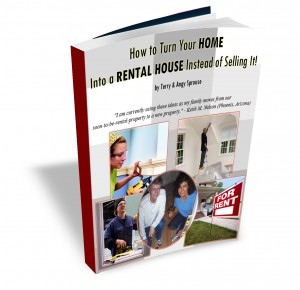Turn a Rental House into Your Home; Then Your Home into a Rental House?
For small fixer upper house investors, like my wife and I, it can pay off big dividends to move into the future rental property that we are repairing. We don’t always do it this way, but we find there are compelling advantages to this technique. These advantages include:
1.) Reduce Financial Strain
We don’t have to make house payments on a property that has no tenants paying rent. In other words, living in the house while we repair it is better than having it empty. If I we live in it, we make the mortgage payment that I would normally have to make anyway. However, if we tried to repair the house, while still living in another house, we have two mortgages to pay, until we can finish repairs on the new house and then rent it out.
This can be a real strain on the budget, especially when repairs go on longer than anticipated. What we like to do is to turn our former home into a rental house and move into the fixer-upper. We usually plan to stay in the new residence anywhere from 6 months to 2 years.
2.) Better Loan Terms
We get better loan terms as an owner occupant. Interest rates on a loan can be one percent lower if we purchase the house as an owner occupant, rather than as an investment property. The less we pay each month during the repair process, the better.
3.) Learn Repair Skills
Instead of rushing through the repair process and having to contract out much of the work, in a more drawn out process we can take the time to learn new repair skills. It also affords us the luxury of being able to make mistakes and learn from them. For me, at least, that is an integral part of the learning process.
4.) Make More Money When Renting
Because of the lower loan terms and lower monthly mortgage payments, when we later rent the property out, we can turn a tidier profit each month. Or, we can make it more attractive to potential tenants by offering to rent it at a lower price.
5.) Accommodates Our 8-5:00 Jobs
Feverishly repairing a new rental property nights and weekends, puts a strain on my wife and I, since we both have day jobs. Stretching out the process reduces the stress level considerably.
6.) Get to Know the House
A slower repair process allows me to really get to know the idiosyncrasies of the house. Later when tenants request repairs, my in-depth knowledge of the house may make these future repairs easier.
7.) Reduce Taxes If We Sell
Although, we believe in the buy-and-hold strategy, if we live in the house for two years and decide to sell, we can sell without paying federal capital gains taxes. If the capital gain is less than $500,000 for couples, the sale of the house is never reported n federal IRS forms.
One Caveat
If you follow this strategy and have a family, expect to live under some primitive circumstances for awhile until you start to get things ship-shape. My kids are thrilled at camping out in a new house, and as long as I get the showers working fairly quickly, my wife is happy. If you take the perspective that it’s an exciting adventure, you won’t be disappointed.
Related Articles
6 Steps to Roof Maintenance (for the Home that will Turn Into a Rental House)
How I Evicted A Problem Tenant in 4 Steps
When to Hire a House Inspector – Radio Interview with Rich Peterson
Getting Rid of Bad Tenants
“Turn your home into a rental” on Mark Wayne Show
7 Reasons to Live in a Fixer-Upper House While You Repair It
6 Steps to Roof Maintenance (for the Home that will Turn Into a Rental House)
Our First Rental House Plunge
10 Most Frequent Problems Found by House Inspectors
5 Steps to Get Your House Ready to Rent by Terry Sprouse
5 Steps to take if your house is flooded
Some perfectly legal ways to maximize your rental profits
Add “Start a Rental House Business” to Your Bucket List
The 5 Rules on How to Lose Money and Get Your Rental Property Trashed by Tenants
Window Repair with #2 Son
Required Roof Maintenance for Fixer Upper Houses
Learn to Repair Your Fixer Upper Houses
How I Got Started In Fixer-Upper Houses
How to learn to operate a fixer upper house business
The Peaceful Warrior and Fixer-Upper Houses









